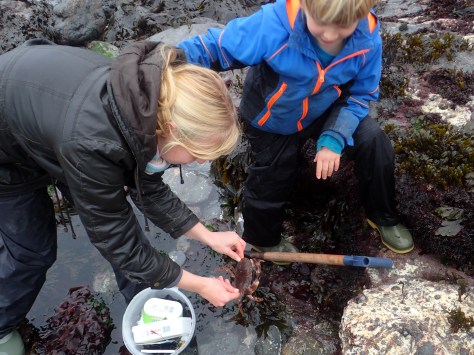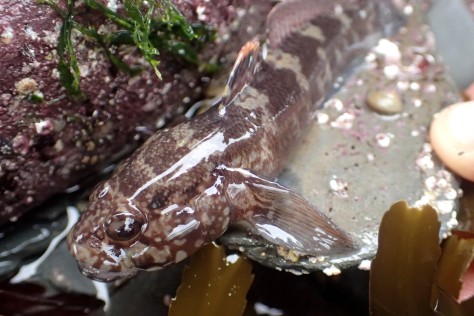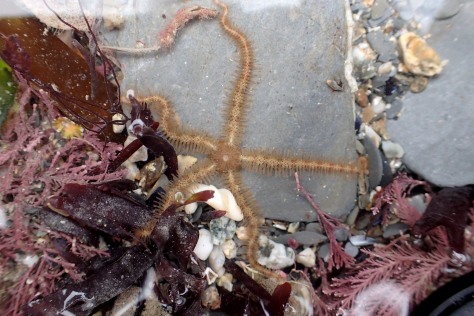Next month, 50 years will have passed since the Torrey Canyon tanker ran aground off the Isles of Scilly, releasing a 700 square km oil slick. On the last day of 2016, I visited Porth Mear to learn how a long-term survey has revealed the secrets of the beach’s fragile recovery, and to see if the St Piran’s hermit crab (Clibanarius erythropus)has managed to make more than a temporary comeback.

When the Torrey Canyon hit rocks in February 1967, its cargo of oil ended up on the Cornish, Breton and nearby coasts. The oil, along with huge quantities of solvent emulsifying chemicals used in an attempt to disperse it, decimated seabird populations and marine wildlife.
Concerned by the impact on his local beach, biology teacher, Richard Pearce, decided to monitor the wildlife on the shore three times a year. He’s been doing his survey without fail ever since.
I wasn’t born when Richard first marked out his quadrats on Porth Mear beach, but I grew up hearing stories of the horror people felt at the sight of the thick black tide, the pervasive smell of the oil, and the woefully unprepared volunteers attempting to shift the cloying oil with garden tools. Decades later, lumps of tar were still washing onto our beaches after every storm.
I’ve always wondered what the process of recovery looked like, so I jumped at the chance to join Richard at Porth Mear for survey number 150.
Survey 150…
It’s clear, after many surveys, that Richard knows the beach well. So well, in fact, that even when the gouged crosses and splodges of green paint that mark the survey quadrats have worn away or been covered up by seaweed, he still knows exactly where they are.

As he shows me his method, calling out the presence and coverage of seaweeds, barnacles and molluscs to his partner, Richard tells me how after the Torrey Canyon disaster the green seaweeds were the first to flourish. With many of the grazing molluscs wiped out by the oil and the chemicals used to disperse it, the seaweeds soon took over. After this other animals gradually returned.

Over the years, Richard has seen many changes. Some are seasonal or weather related, others are harder to explain but may be due to warming seas. Why one pool that was once crammed with mussels now has almost none and why limpets are doing particularly well this season is hard to say, but the data he is collecting reveals changes that would otherwise go unnoticed.

The tide drops and, while Richard is knee-deep examining a quadrat alongside a long deep pool, I explore the lower shore pools, determined to find out whether the St Piran’s crab is still here. After an absence of more than 30 years, this equal-clawed hermit crab started to reappear around Cornwall in 2016 and we had one record on this beach in the spring. Although past records are too patchy to be sure, it’s thought that pollution from the Torrey Canyon played a role in the loss of this species, so 50 years on it would be lovely to find it re-establishing.
Every time I see a shell move, I leap on it, looking for the red legs and spotty eyes, but every one is a common hermit crab (Pagurus bernhardus).

Rooting around in the pools always reveals some unexpected treasures. I make my first record of a stalked jellyfish (Calvadosia cruxmelitensis) at this site.

This is always a good beach for finding Cornish clingfish, and the rocks of the lower shores don’t disappoint. In one small area I find a dozen of these stunning little duck-faced fish, some with iridescent blue spots on their heads.


As I follow a gully across the shore I find several scorpion fish lurking among the rocks. Brittle stars lurch away into the seaweed and Xantho pilipes crabs close up, pretending to be pebbles.
My other half and Junior join me, hunting for crabs and fish. Every thirty seconds I remind them that we need to look for little hermit crabs and they ignore me as they should. They’re used to me and my missions.

Junior at least keeps pointing out suitable pools. He knows they like the ones with pink coralline seaweed and there are lots here. I barely have time to glance at one before he’s trying to drag me to the next.
And then it happens. A shell moves and as soon as I pick it up I know. The legs are red, the shape’s wrong for the common hermit crab. When the crab extends its claws there can be no doubt, they’re hairy and pretty much equal sized. This is a St Piran’s crab.

I yell like I’ve won a golden ticket. Under my camera it’s easy to see the black and white spotty eyes of the crab. We all gather to look and as I take an underwater photo, I see other shells moving.

Sure enough, this next shell has a St Piran’s crab in it, and the next, and the next. While I’m taking photos in the pool, Richard is examining shells on the rock by a small overhang. “There are nine more here,” he says. Soon we’ve counted at least fourteen. They’re all larger than the one found here earlier in 2016.

Whether there are other groups of St Piran’s crabs on this beach is hard to say. The tide is surging in now so we’ve run out of time to search.

The existence of the St Piran’s crab is a fragile one; storms, temperature change, pollution and disturbance threaten our shore wildlife now more than ever. Richard’s survey provides an incredible conservation tool with its wealth of data about what’s here and how it changes.
50 years on from the Torrey Canyon disaster, the confirmation of the St Piran’s crab’s comeback is an uplifting way to complete this survey (and the year).







Brilliant post Heather really enjoyed reading and very informative for mt next foray!
LikeLiked by 1 person
Thanks Lesley – I’m glad you enjoyed reading it. This has to be one of my favourite beaches and I’m in awe of Richard’s dedication to this survey. I hope your next foray goes well – I’d love to hear what you find!
LikeLike
I just love that guy’s dedication. Small wonder, though, as the United Kingdom is and always has been a hotbed for fantastic naturalists like him. It must be in our veins. Looking back at that link to your original Porth Mear blog, I feel a strong urge to revisit Porth Mear. Great stuff as ever, Heather. *Yes, I may be a poet and didn’t know it, hmmm.
LikeLiked by 1 person
A wonderful story, and how lucky we are that people with passion record what is happening so that we might understand better. I was very little when the accident happened, but remember my Cornish beach days on the north coast being blighted with thick tar getting stuck to my feet and clothes, and the what seemed like hours of cleaning when we got back to my grandparent’s home in Flushing.
LikeLiked by 2 people
Hi Scooj, Yes, the tar stayed around for a very long time. In the storms last year a load of sand washed off the top of Mawgan Porth beach and revealed a layer of thick tarry sand which was apparently left over from the Torrey Canyon. Unfortunately the government response to the disaster made things very much worse – the use of strong chemical detergents on the shore is what killed much of the wildlife. It feels great to share this positive story that’s come out of the disaster. Richard’s done an amazing job.
LikeLiked by 2 people
In true British style, he was also very humble about the staggering amount of work he’s done and the impressive scientific knowledge that has gone into designing and conducting these studies. Truly inspiring! And yes, Porth Mear is very well worth a visit – just pick a good tide with reasonably calm weather and allow plenty of time to get to the lower shore (lots of rocks to cross). Thanks Tony and Happy New Year to you!
LikeLiked by 1 person
Hi can you help me? I have been looking at some seashells and I need some help on IDing some of them.
LikeLike
Hi Sean, Sounds like fun! I’ve just been shell collecting today myself. Could you click on contact me & send me a message there & then we can email to exchange photos/ideas – or otherwise you can send a message through my Cornish Rock Pools Facebook with pics if you have them. I’ll look forward to hearing more. 🙂 All the best, Heather
LikeLike